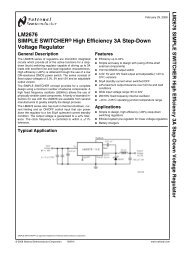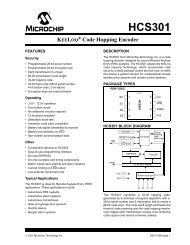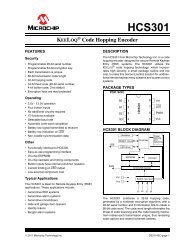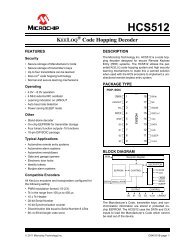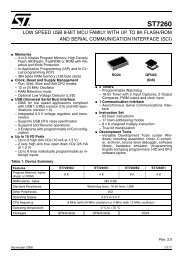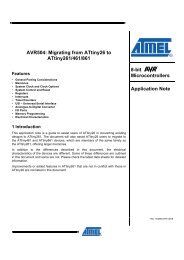dsPIC30F2010 Data Sheet - Microchip
dsPIC30F2010 Data Sheet - Microchip
dsPIC30F2010 Data Sheet - Microchip
Create successful ePaper yourself
Turn your PDF publications into a flip-book with our unique Google optimized e-Paper software.
<strong>dsPIC30F2010</strong><br />
5.1 Interrupt Priority<br />
The user-assignable Interrupt Priority (IP) bits for<br />
each individual interrupt source are located in the Least<br />
Significant 3 bits of each nibble, within the IPCx register(s).<br />
Bit 3 of each nibble is not used and is read as a<br />
‘0’. These bits define the priority level assigned to a<br />
particular interrupt by the user.<br />
Note:<br />
The user-assigned priority levels are from<br />
0, as the lowest priority, to level 7, as the<br />
highest priority.<br />
Since more than one interrupt request source may be<br />
assigned to a specific user-assigned priority level, a<br />
means is provided to assign priority within a given level.<br />
This method is called “Natural Order Priority” and is<br />
final.<br />
Natural Order Priority is determined by the position of<br />
an interrupt in the vector table, and only affects<br />
interrupt operation when multiple interrupts with the<br />
same user-assigned priority become pending at the<br />
same time.<br />
Table 5-1 lists the interrupt numbers and interrupt<br />
sources for the dsPIC DSC devices and their<br />
associated vector numbers.<br />
Note 1: The natural order priority scheme has 0<br />
as the highest priority and 53 as the<br />
lowest priority.<br />
2: The natural order priority number is the<br />
same as the INT number.<br />
The ability for the user to assign every interrupt to one<br />
of seven priority levels means that the user can assign<br />
a very high overall priority level to an interrupt with a<br />
low natural order priority. For example, the PLVD (Low-<br />
Voltage Detect) can be given a priority of 7. The INT0<br />
(external interrupt 0) may be assigned to priority<br />
level 1, thus giving it a very low effective priority.<br />
TABLE 5-1:<br />
INT<br />
Number<br />
Vector<br />
Number<br />
<strong>dsPIC30F2010</strong> INTERRUPT<br />
VECTOR TABLE<br />
Interrupt Source<br />
Highest Natural Order Priority<br />
0 8 INT0 – External Interrupt 0<br />
1 9 IC1 – Input Capture 1<br />
2 10 OC1 – Output Compare 1<br />
3 11 T1 – Timer1<br />
4 12 IC2 – Input Capture 2<br />
5 13 OC2 – Output Compare 2<br />
6 14 T2 – Timer2<br />
7 15 T3 – Timer3<br />
8 16 SPI1<br />
9 17 U1RX – UART1 Receiver<br />
10 18 U1TX – UART1 Transmitter<br />
11 19 ADC – ADC Convert Done<br />
12 20 NVM – NVM Write Complete<br />
13 21 SI2C – I 2 C Slave Interrupt<br />
14 22 MI2C – I 2 C Master Interrupt<br />
15 23 Input Change Interrupt<br />
16 24 INT1 – External Interrupt 1<br />
17 25 IC7 – Input Capture 7<br />
18 26 IC8 – Input Capture 8<br />
19 27 Reserved<br />
20 28 Reserved<br />
21 29 Reserved<br />
22 30 Reserved<br />
23 31 INT2 - External Interrupt 2<br />
24 32 Reserved<br />
25 33 Reserved<br />
26 34 Reserved<br />
27 35 Reserved<br />
28 36 Reserved<br />
29 37 Reserved<br />
30 38 Reserved<br />
31 39 Reserved<br />
32 40 Reserved<br />
33 41 Reserved<br />
34 42 Reserved<br />
35 43 Reserved<br />
36 44 INT3 – External Interrupt 3<br />
37 45 Reserved<br />
38 46 Reserved<br />
39 47 PWM – PWM Period Match<br />
40 48 QEI – QEI Interrupt<br />
41 49 Reserved<br />
42 50 Reserved<br />
43 51 FLTA – PWM Fault A<br />
44 52 Reserved<br />
45-53 53-61 Reserved<br />
Lowest Natural Order Priority<br />
DS70118J-page 38<br />
© 2011 <strong>Microchip</strong> Technology Inc.





